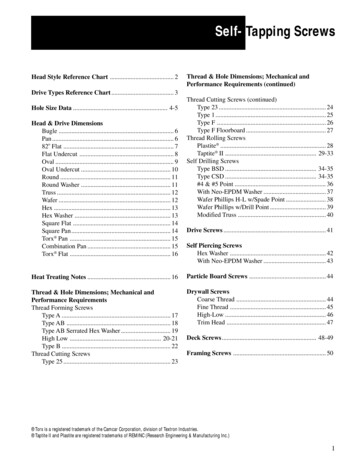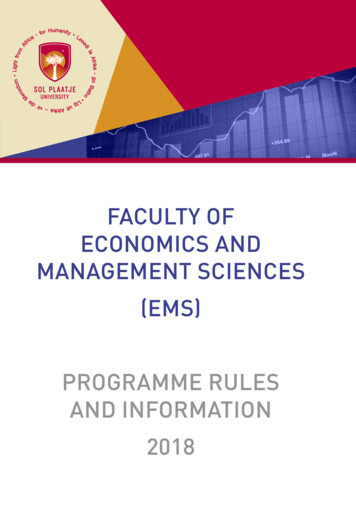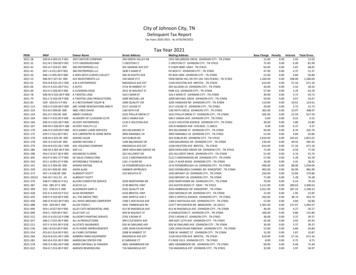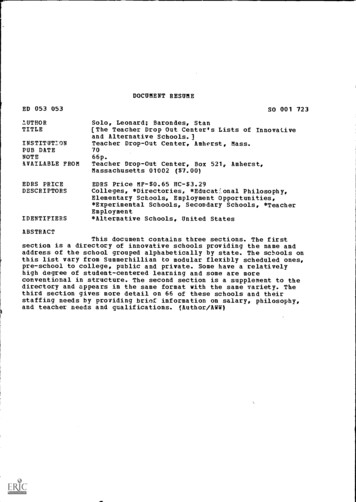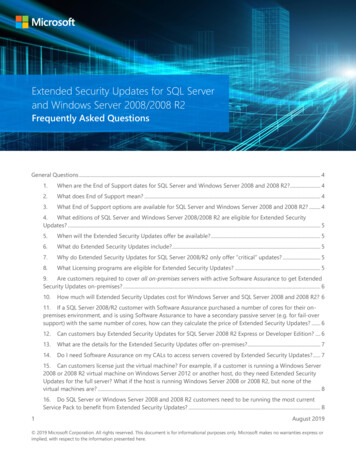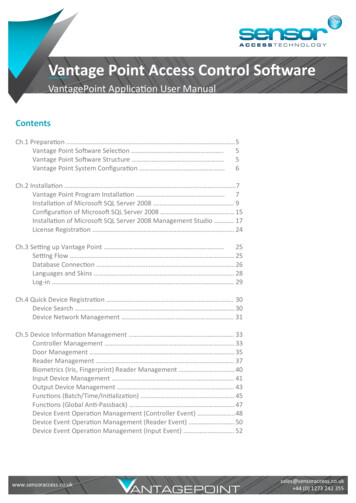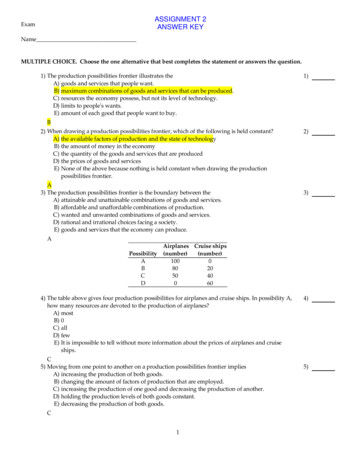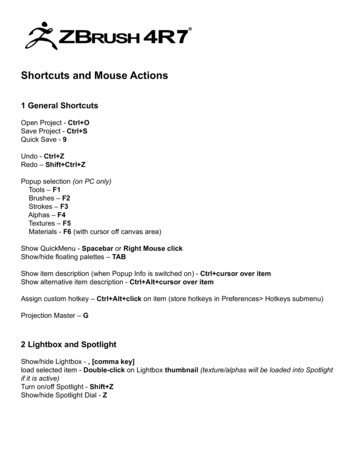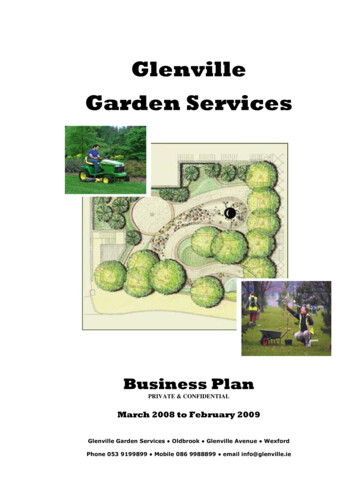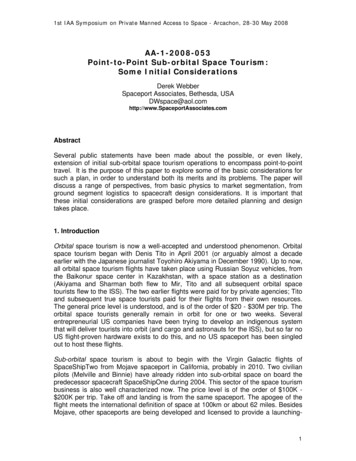
Transcription
1st IAA Symposium on Private Manned Access to Space - Arcachon, 28-30 May 2008AA-1-2008-053Point-to-Point Sub-orbital Space Tourism:Some Initial ConsiderationsDerek WebberSpaceport Associates, Bethesda, omAbstractSeveral public statements have been made about the possible, or even likely,extension of initial sub-orbital space tourism operations to encompass point-to-pointtravel. It is the purpose of this paper to explore some of the basic considerations forsuch a plan, in order to understand both its merits and its problems. The paper willdiscuss a range of perspectives, from basic physics to market segmentation, fromground segment logistics to spacecraft design considerations. It is important thatthese initial considerations are grasped before more detailed planning and designtakes place.1. IntroductionOrbital space tourism is now a well-accepted and understood phenomenon. Orbitalspace tourism began with Denis Tito in April 2001 (or arguably almost a decadeearlier with the Japanese journalist Toyohiro Akiyama in December 1990). Up to now,all orbital space tourism flights have taken place using Russian Soyuz vehicles, fromthe Baikonur space center in Kazakhstan, with a space station as a destination(Akiyama and Sharman both flew to Mir, Tito and all subsequent orbital spacetourists flew to the ISS). The two earlier flights were paid for by private agencies; Titoand subsequent true space tourists paid for their flights from their own resources.The general price level is understood, and is of the order of 20 - 30M per trip. Theorbital space tourists generally remain in orbit for one or two weeks. Severalentrepreneurial US companies have been trying to develop an indigenous systemthat will deliver tourists into orbit (and cargo and astronauts for the ISS), but so far noUS flight-proven hardware exists to do this, and no US spaceport has been singledout to host these flights.Sub-orbital space tourism is about to begin with the Virgin Galactic flights ofSpaceShipTwo from Mojave spaceport in California, probably in 2010. Two civilianpilots (Melville and Binnie) have already ridden into sub-orbital space on board thepredecessor spacecraft SpaceShipOne during 2004. This sector of the space tourismbusiness is also well characterized now. The price level is of the order of 100K 200K per trip. Take off and landing is from the same spaceport. The apogee of theflight meets the international definition of space at 100km or about 62 miles. BesidesMojave, other spaceports are being developed and licensed to provide a launching-1
1st IAA Symposium on Private Manned Access to Space - Arcachon, 28-30 May 2008off point for sub-orbital space tourism (examples include New Mexico andOklahoma). Several competing systems are being developed to provide options forthe sub-orbital space tourist, and they offer a variety of architectures. However, theyhave in common that the true duration of the spaceflight experience itself is onlyabout 5 minutes near the flight’s apogee.Market surveys have established that commercial demand exists for both orbital andsub-orbital space tourism at these established price levels.However, an entirely different category of private commercial spaceflight has beenproposed, known as point-to-point sub-orbital space flight (see Fig 1). Thecharacterization of this kind of space flight is not nearly so well established as is thecase for the former two categories. Credible market studies have not been done, orat least published. The optimum technical design has not been established. Theground infrastructure is not in place. Price levels are uncertain. It is not even clearwhether such flights are best characterized as tourism or as transportation; whetherthe passengers would be primarily tourists or business persons on urgent trips; orindeed whether the demand would be primarily military. It is not established whetherthe market for this capability would be for people or cargo, or for combinations ofboth. The author believes that it is important that some of these fundamental issuesare addressed before work proceeds on detailed design for a vehicle aimed atserving this market. Clearly, the design, and even sizing, of such a vehicle would varysignificantly depending upon the resolution of some of these issues. This paperattempts to create a frame of reference for discussing the main aspects of this newsector, in order to provide some clarity for industry planners.Fig 1 Point-to-Point Sub-orbital Space Travel Routes( Courtesy Spaceport Berlin and www.spacetransport.de)2
1st IAA Symposium on Private Manned Access to Space - Arcachon, 28-30 May 20082. Basic Physics of Point-to-Point Sub-orbital SpaceflightThere are a number of aspects of the proposed new class of space travel that areconstrained by the laws of physics. So it is clearly important to appreciate theselimitations before proposing any impossible design objectives.Perhaps the most basic fact of life is that it takes 90 minutes to orbit the Earth ataltitudes of 100 miles or so. As the altitude increases beyond this level, the timeperiod increases, until of course at Geostationary altitude, a spacecraft takesprecisely one day to orbit the Earth. We cannot go faster in free fall than the 90minutes around the Earth, or 45 minutes to go halfway around the Earth (say fromLondon to Sydney).As a consequence of this, we see that the speed for orbital travel, or shall we saypoint-to-point hemi-spherical travel, is very high at around 17,500 mph. This issignificantly greater (an order of magnitude greater) than the speed needed for suborbital lobs above a spaceport. When the sub-orbital spacecraft reaches its maximumaltitude, of say 62 miles, then its horizontal speed is almost zero. From thiscomparison, we can see that the intercontinental point-to-point space travel has morein common with orbital travel or ICBM trajectories than with sub-orbital lobs. Theimplications of this, except for the special case of sub-orbital lobs to spaceports inclose proximity to the point of takeoff, are discussed in Section 5 below, but includemajor design challenges for handling the trans-atmospheric and re-entry phases.To perform an intercontinental point-to-point trajectory, a vehicle must be designedthat can both attain the speeds necessary, and manage the thermal environment oftransiting the atmosphere both during takeoff and landing. Such a vehicle is generallydescribed as a hypersonic vehicle, and it needs to have engines, thermal controlsystems, and stability control systems that are considerably more advanced thanthose needed for sub-orbital lobs.3. Commercial Market Considerations – is it Tourism or Business Travel?There are fundamental market issues that are probably so significant that no furtherwork on anything else related to commercial point-to-point sub-orbital space flight ismerited until they are resolved.The first question needing resolution is whether this class of vehicle is needed forcargo, or for passengers? Or just possibly for a combination? If the vehicle is forpassenger travel, is it for space tourists, or for urgent travel, presumably related tobusiness? We shall find throughout this paper that the issues are overlapping, andtherefore cannot easily be resolved, or even researched, in isolation. For example, toeven address the stated market questions, it is necessary to have an idea of the priceof a ticket to ride (whether for persons, or cargo). And in order to know the likelyregion of ticket price, it is necessary to know the cost of building and operating thevehicle and its ground infrastructure. To know the cost of building and operating, oneneeds to know the size of the vehicle and the number of passengers or amount ofcargo, carried, and the number of spaceport destinations. And that presupposes that3
1st IAA Symposium on Private Manned Access to Space - Arcachon, 28-30 May 2008we know how many people would want to fly in the first place, between any given pairof spaceports. So the argument is circular and iterative. Nevertheless a solution mustbe attempted.When the argument is circular, then the best chance at finding a solution is generallyto construct a multi-dimensional solution space, in this case covering a range ofprices and vehicle sizes, and ground infrastructures. For the case of passengertravel, the solution space will provide a different answer depending on whether thetrip is considered as “fast travel” or “space tourism”. A different solution space willemerge in the case of urgent cargo delivery, too. Thus it seems that three sets ofresults are needed, and they could be presented on three charts as demonstrated byFig 2, Fig 3 and Fig 4.Fig 2 The Case of Urgent Business TravelFig 3 The Case of Extended Sub-orbital Space Tourism Experience4
1st IAA Symposium on Private Manned Access to Space - Arcachon, 28-30 May 2008Fig 4 The Case of Fast Cargo DeliveryIn order to understand the commercial markets and find data to populate the charts,some credible new market research surveys will be required. No questions aboutpoint-to-point sub-orbital space travel were included in any of the previouslypublished robust space tourism surveys (such as the Futron/Zogby Survey, theAdventurers’ Survey, the LaTrobe University Survey, or the SEI work.) In exploringthe “Urgent business travel” perspective, we can start with Concorde ticket prices andexplore the extent to which travelers would pay various premia above those prices tohave the benefits of the much shorter journey times of sub-orbital point-to-pointtravel. For the “Space tourism experience” perspective, we can start with the knownprices for straight up-and-down sub-orbital space tourism, and explore how much of apremium would be acceptable for a flight say half way around the Earth in 40minutes. For the “Fast cargo” perspective, it would be necessary to explore theextent to which folks would pay above the current international “overnight” courierrates to get their cargo to its spaceport destination in say 40 minutes. Of course, for abusiness case to close, it must be possible to provide the service at costs that arebelow the assumed prices. So, we suspect that prices will be at least 100K perpassenger, and probably much higher.In all three perspectives, it will be important to obtain additional, more detailed,information from this new survey. For example, in the Fig 2 case, we would benefitfrom finding out what kinds of trips are so urgent, and most importantly what are thekey pairs of spaceports required. In the Fig 3 example, it would be useful to exploreother aspects about the new space tourism experience, eg how to return to base. Inthe Fig 4 cargo option, we need to understand what kinds of cargo would justify theprice premium.In all three cases, however, we need to be aware that the “global” demand solutionswill only be approachable if large numbers of spaceports are involved. In the casewhen only a few pairs of spaceports are assumed to be offering the service, then onlya proportionate share of the global total market will be achievable (although this maynot be so critical in the “Space tourism experience” perspective).5
1st IAA Symposium on Private Manned Access to Space - Arcachon, 28-30 May 2008Of course, we should not forget that there may be a government/military demand thatoperates beyond normal commercial supply and demand constraints.4. Ground Segment Considerations – How Many Spaceports?It has been suggested that a variant on the sub-orbital straight up and down spacetourism flights from Mojave spaceport in California might be a take-off at Mojave anda landing at a relatively “neighboring” spaceport, such as at Oklahoma. Although, asexplained above, no published market data yet exists on incremental demand for thiskind of “stretched” sub-orbital space tourism, it does seem that there would be some,depending on price premium. It would not be necessary for many spaceports tooperate in order to offer this variant on the space tourism experience, provided thatthe performance of the sub-orbital vehicle systems can be stretched to provide thetrip (but see section 5 below for important limitations in meaning of “neighboring”).The V-Prize foundation in Virginia, USA, has begun to explore using point-to-pointsub-orbital space travel from Wallops spaceport on its Atlantic coast to an, as yetunnamed, single European destination (ref 7.1, 7.2. 7.3). Although the detailed prizerules remain to be finalized, their intention is to encourage development of a craftcapable of making international point-to-point trips from their State’s spaceport. Todesign a craft to carry out intercontinental sub-orbital travel, however, requires someconfidence that a commercial market exists for continued use of the vehicle classafter the prize has been won. In the case of the X-Prize which was won in 2004, theprize rules envisaged a new class of vehicle capable of providing sub-orbital spacetourism. Burt Rutan’s SpaceShipOne was eventually successful, 8 years after theprize was announced, and became the prototype enabling Virgin Galactic to initiatethe sub-orbital space tourism industry. What kind of a commercial transportationindustry could be initiated by carefully crafted V-Prize rules? We can safely assumethat the answer would be “none” if the number of involved spaceports remained atonly the Virginia spaceport and its counterpart European site. If the potential newindustry is for urgent business travel, or for fast cargo, then it will be necessary to setup an eventual global network of participating spaceports needing to be located nearto major population centers.Why? Because most of the time savings achieved by point-to-point sub-orbital spaceflight are of no benefit, if the time spent on the ground getting to the new spaceport isjust a few hours more than it takes today to get to the local existing internationalairport. Clearly, one cannot expect the entire world to set up spaceports to parallel itsairport locations overnight. And even if it becomes possible to sometimes integrate aspaceport within an existing airport administration and boundary, it would beimportant to first establish the prime routes. Of course, this inevitably initially restrictsthe demand to only a share of potential global values. One of the results of the newmarket survey described in Section 3 would be to try to assess what should be theinitial prime route inter-spaceport network. In exploring the effects of these logisticassumptions on the market demand, we are of course ignoring some rather majorquestions for subsequent resolution. Questions such as how would the global AirTraffic Control system handle this new vehicle class? Questions such as who wouldbe expected to pay for the establishment of the global network of spaceports? Whowould establish global spaceport operating standards? These questions would be6
1st IAA Symposium on Private Manned Access to Space - Arcachon, 28-30 May 2008capable of answers once a clear commercial market need is established, but they arenot minor in nature, and therefore would have a bearing on the likely timeframe forintroducing a true global point-to-point sub-orbital space travel industry.Nor are the ground segment logistics limited to the mere location and number ofspaceports. Depending on the kind of travel and/or cargo, a range of infrastructureelements will be needed at the spaceports. Clearly, as with airports today, there willbe the need for fuel storage, in this case rocket fuel. Maintenance facilities will beneeded for inspection and replacement of key system elements, such as thermalcontrol subsystems and engine parts. Special cargo handling areas will be needed,depending upon the nature of the high-value cargos to be shipped. If transplantorgans would be one such cargo category, for example, then extraordinarycleanliness and temperature controls will be needed. Because of the urgency of the(non-tourism) flights, there will be a need for highly efficient loading anddocumentation and customs procedures.An important consideration, linked to the overall demand figures, would be thefrequency of flights. Someone needing such an urgent flight needs to go now, notthree or four hours from now. In this kind of operation, the urgent business travelflights would be arranged on a corporate jet travel basis, ie flights would need to goon demand, and not according to a pre-arranged schedule. The need for on-demandservice is because, if flights are only going twice or thrice a day, say, between twogiven spaceports, then it would be just as quick and a lot cheaper to fly the person orthe cargo on an earlier airline flight the same day. Therefore, unless there are at leastabout 1000 scheduled point-to-point sub-orbital flights a year between any given pairof spaceports, then the urgent travel customer, or the fast cargo client, will havequicker and cheaper solutions using regular existing aircraft services. There are ofcourse fleet size implications if it is decided to operate an on-demand serviceVehicle design aspects are discussed in Section 5 below, but it is clear that it iseasier to fill a smaller vehicle (say 3 passengers) to be able to go at a moment’snotice than to fill something, say, Concorde size. This would be an important part ofan iterative solution. How many craft of what size would be flying how many times aday between how many spaceports in order to satisfy the demand?Not until the new market research, described in Section 3 above, has beenconducted, can we know if sufficient commercial market demand exists to fill thatamount of travel between any two spaceports. Again, we are aware that militaryfacilities could be used to satisfy military demand outside of commercialconsiderations.5. Spacecraft Design AspectsFor the special case of a flight from a spaceport to another one in close proximity,(say within a few hundred kilometers), it may be possible to “stretch” the design of acurrently planned sub-orbital space tourism vehicle to carry out the mission. Themain requirement would be to carry more propellant, or install an auxiliary apogeeboost motor, to translate the vehicle horizontally while above the atmosphere. Somesimplistic, but nevertheless enlightening, calculations on this approach follow.7
1st IAA Symposium on Private Manned Access to Space - Arcachon, 28-30 May 2008We use the data from the SpaceShipOne flights conducted in 2004. In each of itsthree parabolic flights into space, the spacecraft was first carried to about 50,000 ftby its mother craft White Knight. It was then released, and its rocket motor was firedfor about 80 seconds. It then continued to coast upwards to apogee (328,000ft, or 62miles) for another 100 seconds, thereby achieving its maximum altitude in 3 minutesfrom the start of motor firing. The spacecraft then took another 3 minutes to fall backto around 50,000 feet again, before its gradual 18 minute glide back to its base atMojave Spaceport. Thus, if we wish to “stretch” the lob so that it allows for a lineartranslation, we have only 6 minutes in which to do it before re-entry into the denseatmosphere. Even if we can loft the additional fuel and/or translation motor to makean attempt at point-to-point travel, a simple calculation shows that, traveling atSpaceShipOne’s Mach 3, the distance achieved in this time interval with no assumedincrease in apogee can only be of the order of 200 miles. This is the distance fromMojave to San Diego, or Las Vegas, say, rather than the 1500 miles from Mojave toOklahoma spaceport, and is certainly not enough for intercontinental travel. A morerefined analysis would be unlikely to provide a significantly different outcome for thescale of geographical limitations of this simple “stretched” sub-orbital design concept.For true intercontinental or “hemispheric” point-to-point sub-orbital space travel,therefore, a new class of vehicle would be needed, the hypersonic transport. Theytravel at or beyond Mach 7, and crew and/or cargo would experience high-g loadingspossibly in excess of 8g. Although at present no such vehicles, nor their engines,have been built, (except for the case of ramjet powered cruise missiles), there arenevertheless a number of theoretical design concepts, starting with the SangerAmerika transcontinental bomber of World War II. At this conference, one suchdesign is presented by the DLR representatives (ref 7.4, 7.5). Design solutions mightinclude wave-rider technology that allows for skipping along the top of theatmosphere, and combinations of atmospheric and exo-atmospheric transportation.Fig 4 shows the design concept by Planetspace, Inc., known as Silver Dart, arrivingat a destination spaceport.Photo courtesy Planetspace.Fig 4. The hypersonic transport concept Silver Dart.8
1st IAA Symposium on Private Manned Access to Space - Arcachon, 28-30 May 2008Clearly, the sizing of the vehicle is a major determinant of the design. But, asobserved in Section 3, we do not know at present whether the commercial marketrequires a cargo carrier or a passenger vehicle. And in the case of a passengervehicle, we do not know whether the demand would support a 3-seater or a 100seater. Notwithstanding the observations in Section 4, we do not know whether theywill be flying on daily schedules between hundreds of space ports or whether they willbe small craft flying on demand. And most importantly, we do not know the ticketprices (although we do expect that they will probably be at least 100K).Flight trajectories would of course be coordinated through international air trafficcontrol. Some designs assume glide landings; others assume a landing under power,which latter is clearly a better situation for air traffic control to manage. Specialattention is needed to handle the dissipation of heat engendered by hypersonic flightin those phases of the trip that take place in the atmosphere (generally at the startand end of the flight, but possibly also during the flight for skip trajectories). Thiswould require the development of new re-usable thermal control systems, and mightbe managed by use of high temperature materials, or ablative techniques requiringrefurbishment at destination. Engines would probably have to be of Ramjet, or moreprobably of Scramjet or combined cycle, technology. Engine and thermal systemspares would be needed at the spaceports that form part of the network. Because theprime route networks will inevitably traverse populated areas, consideration will needto be given in suppressing the sonic boom for such transports, because the sonicboom was one reason for the limitation of Concorde flights over the USA. Detaileddesign of a hypersonic transport for commercial point-to-point sub-orbital space travelcould proceed if basic parameters such as market requirements can be established.Of course, we recognize that there would be additional USAF needs that wouldsignificantly modify the design specifications if this class of vehicle were to be usedfor military purposes.6. ConclusionBefore it can be determined if a new industry sector of commercial point-to-point suborbital space travel can be financially viable, some critical new market research isneeded, and this paper has described what needs to be surveyed. The objective ofthe survey must be to determine whether this kind of space travel would serve onlyas a premium variant on the sub-orbital space tourism experience, or whether it couldserve urgent business travel or fast cargo needs. It would also have key implicationsfor vehicle size, flight rates, and the location and number of global spaceports. Quiteregardless of vehicle design solutions, the limitations imposed by ground logisticswould constrain the use for urgent travel and cargo delivery services. Urgent travel orcargo delivery would require on-demand, rather than scheduled, services. This newmarket research work is required before any detailed planning or vehicle design forcommercial flights can take place. If there emerges a military need for this form ofspace travel, then of course we could expect that the financial and market constraintswould be alleviated.9
1st IAA Symposium on Private Manned Access to Space - Arcachon, 28-30 May 20087. References7.17.27.37.47.5de Brem, P,The V-Prize: One hour to Europe, The Space Review 8-27-07Sabathier, V G, The Future of Point-to-Point Space Transportation, Centerfor Strategic and International Studies 2-4-08Kennedy, J and Dunstan, J, The V-Prize, V-Prize Foundation 2-4-08Sippel, M,Promising Roadmap Alternatives for the Space Liner, IAA’sFirst Symposium on Private Human Access to Space, Arcachon, May 2008van Foreest, A, The Logistical Challenges of the Space Liner Concept, IAA’sFirst Symposium on Private Human Access to Space, Arcachon, May 200810
the "Urgent business travel" perspective, we can start with Concorde ticket prices and explore the extent to which travelers would pay various premia above those prices to have the benefits of the much shorter journey times of sub-orbital point-to-point travel. For the "Space tourism experience" perspective, we can start with the known
![MRP [modalità compatibilità ] - Roma Tre University](/img/62/mrp.jpg)
